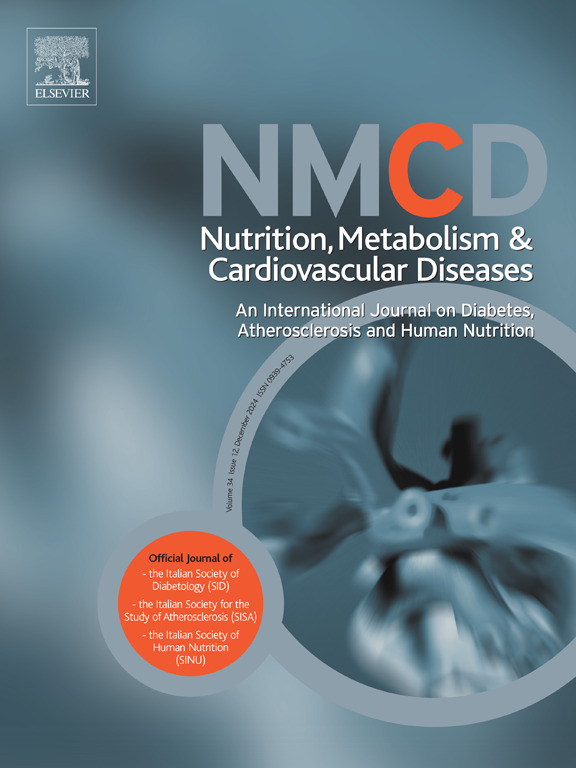Serum iron levels predict mortality risk in hypertensive patients: A prospective cohort study
IF 3.3
3区 医学
Q2 CARDIAC & CARDIOVASCULAR SYSTEMS
Nutrition Metabolism and Cardiovascular Diseases
Pub Date : 2025-03-15
DOI:10.1016/j.numecd.2025.104017
引用次数: 0
Abstract
Background and aim
This study aimed to investigate the relationship between serum iron levels and mortality risk in hypertensive patients.
Methods and results
A total of 15,181 hypertensive patients were included and stratified into four groups based on serum iron levels (Quartile 1 to Quartile 4). Patients were followed for an average of 85.24 ± 1.16 months. The proportions of all-cause mortality across Quartiles 1 through 4 were 16.96 %, 14.65 %, 13.47 %, and 12.15 %, respectively (p < 0.001), while the cardiovascular mortality rates were 5.06 %, 3.67 %, 3.46 %, and 2.84 %, respectively (p < 0.001). After adjusting for confounders, the risks of all-cause and cardiovascular mortality were significantly lower in Quartile 2 (hazard ratio [HR] = 0.80, p = 0.060; HR = 0.57, p = 0.004), Quartile 3 (HR = 0.76, p = 0.050; HR = 0.58, p = 0.010), and Quartile 4 (HR = 0.64, p < 0.001; HR = 0.45, p < 0.001) compared to Quartile 1. Restricted cubic spline regression revealed a significant negative association between serum iron levels and the risks of all-cause and cardiovascular mortality. Additionally, mediation analysis showed that body mass index (BMI), serum creatinine, and lipid profile partially mediated the effect of serum iron on mortality risk.
Conclusions
Elevated serum iron levels were related to lower risks of mortality in hypertensive patients. BMI, serum creatinine, and lipid profile mediated this relationship, suggesting a potential interplay between metabolic and renal factors in modulating the effect of serum iron on mortality.

血清铁水平可预测高血压患者的死亡风险:前瞻性队列研究
背景与目的:本研究旨在探讨高血压患者血清铁水平与死亡风险的关系。方法与结果:共纳入15181例高血压患者,根据血清铁水平(四分位数1 ~四分位数4)分为4组,平均随访时间85.24±1.16个月。1 ~ 4四分位数的全因死亡率分别为16.96%、14.65%、13.47%和12.15% (p)。结论:血清铁水平升高与高血压患者死亡风险降低有关。BMI、血清肌酐和脂质谱介导了这种关系,表明代谢和肾脏因素在调节血清铁对死亡率的影响方面存在潜在的相互作用。
本文章由计算机程序翻译,如有差异,请以英文原文为准。
求助全文
约1分钟内获得全文
求助全文
来源期刊
CiteScore
6.80
自引率
2.60%
发文量
332
审稿时长
57 days
期刊介绍:
Nutrition, Metabolism & Cardiovascular Diseases is a forum designed to focus on the powerful interplay between nutritional and metabolic alterations, and cardiovascular disorders. It aims to be a highly qualified tool to help refine strategies against the nutrition-related epidemics of metabolic and cardiovascular diseases. By presenting original clinical and experimental findings, it introduces readers and authors into a rapidly developing area of clinical and preventive medicine, including also vascular biology. Of particular concern are the origins, the mechanisms and the means to prevent and control diabetes, atherosclerosis, hypertension, and other nutrition-related diseases.

 求助内容:
求助内容: 应助结果提醒方式:
应助结果提醒方式:


